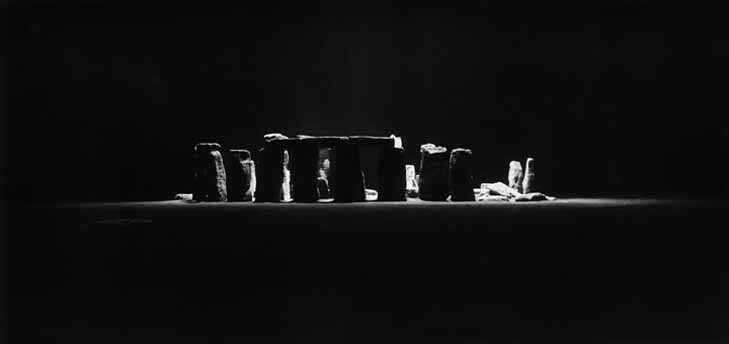Stonehenge at Night, 1944
 [Image: "Stonehenge at Night" (1944) by Harold Edgerton].
[Image: "Stonehenge at Night" (1944) by Harold Edgerton].In 1944, Harold Edgerton, one of the forefathers of stroboscopic photography, produced an extraordinary image of Stonehenge. According to the authors of Stopping Time, that image was commissioned specifically as part of a larger military/optical experiment:
- Illuminated by a 50,000 watt-second flash in the bay of a night-flying airplane 1500 feet above the ancient monoliths, Edgerton's pictures of Stonehenge served as a demonstration to the Allied commanders of the potential for nighttime reconaissance photography. Edgerton was on the ground with a folding pocket camera braced on a fence post as the plane flew overhead. Simultaneously, the monument was recorded in perfect detail by a camera in the plane. The target was chosen because it was remote enough to allow the equipment to be tested without arousing unwanted interest.
But the idea of a stroboscopic light-bay opening up in the base of an aircraft and illuminating scenes of human prehistory from above is breathtaking—as if dropping illuminative ordnance into a world of darkness, far below. Indeed, as a photographic technique, pinpoint-flashes of high-powered aerial lighting would also be something well worth exploring in other archaeo-architectural contexts, from Angkor Wat to the Spiro Mounds. Light-bomb archaeology.
(Thanks, Nat!)





Comments are moderated.
If it's not spam, it will appear here shortly!
aerial photon bombardment; photons numbered in ways that can best be expressed via either scientific notation or the simple expression "a fuck-ton."
Cool! Is that the highest res image you have? I'd love to have that in a blown-up printout.
Impressive and pretty awesome, for that time!
It's fortunate that they used such a recognizable landmark for this test - for some reason I doubt that the British government would allow Stonehenge to be a subject nowadays, for whatever esoteric environmental reasons. Although all's fair in love and war...
If someone wanted a higher res picture, it's probably available from the goverment without restriction. Most photos created by the US government don't have copyright descriptions as they are payed for by us all.
I wonder if Edgerton ever met Muybridge. I think a case could be made that these two photographers did much to shape our modern concepts of what time, space, and movement were all about.
"I wonder if Edgerton ever met Muybridge."
Given that Edgarton was born just a year earlier than Muybridge's death I don't believe that if they had met the discussion would have been very technical.
I wonder if Stanley Kubrick or Arthur C. Clarke ever saw this image before they started collaborating on the script of "2001: A Space Odyssey".
How on earth did he get the camera on the ground to sync with the flash???
Camera on the ground was probably wide open. Stonehenge is in the country, where it's pitch-black. No need to sync anything.
Post a Comment